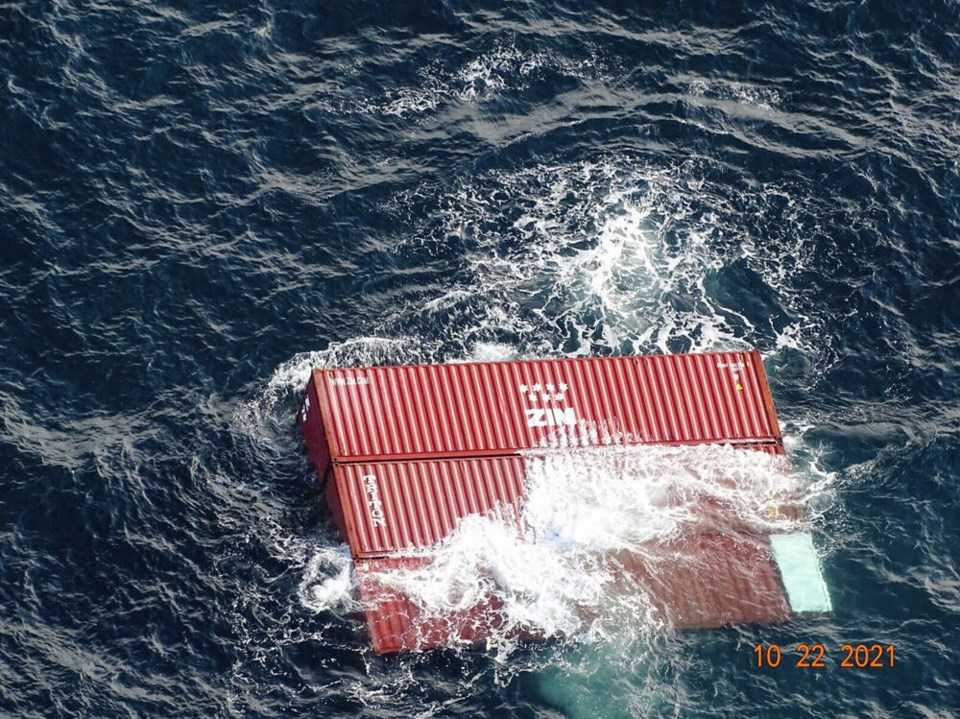Even before the flames on the container ship were extinguished, some clever soul set up a @ZimKingston parody account on Twitter.
“We have engaged local salvage experts to locate and collect our missing shipping containers,” read one post — above a photo of Relic and Nick from The Beachcombers.
It’s actually rare for containers to go into the sea. World Shipping Council stats show that fewer than 1,400 containers — less than a thousandth of a per cent of the 226 million shipped — are lost that way in a typical year.
Still, there has been a spike in the past couple of years. And five years ago, the west coast of Vancouver Island was littered with the wreckage of 35 empty containers that escaped from the container ship Hanjin Seattle. An account of the subsequent cleanup can be found at clearseas.org, the website of the Vancouver-based Clear Seas Centre for Responsible Marine Shipping.
And now there’s this latest incident, in which 40 sea cans, as they are known, went overboard from the Zim Kingston as it approached Juan de Fuca Strait on Friday, a day before fire broke out on the vessel.
The U.S. and Canadian coast guards were tracking 35 of the containers west of the Island on Monday. Bad weather was hindering their recovery.
The public was warned not to open any containers they find, as two hold harmful chemicals. Instead, call 1-800-889-8852.
The thing is, as much as lost containers can be both a navigation hazard and a source of pollution, people have a fascination with the flotsam spat up by the sea. The west coast of the Island has a long tradition of beachcombing, whether for Japanese fishing floats or entire sea cans that come ashore like giant Kinder Surprises.
Once, decades ago, Tofino residents filled their heads with visions of seaborne treasure as a stainless-steel refrigerated shipping container bobbed toward a local beach. Unfortunately, when they cracked it open, all they found was salal, bear grass and evergreen huckleberry, bound for florists in New Zealand. Coals to Newcastle.
On another occasion, Tofitians swarmed Chesterman Beach after a shipping container spilled its load of of cedar shake blocks. Residents trotted off the sand with full wheelbarrows, only to trot back again on the orders of the police, who said the rightful owners were coming.
But when no one appeared to collect the shake blocks, back came the wheelbarrows.
Another time, two-metre lengths of rough-cut mahogany four-by-fours came ashore. Also, some residents pretty much build their houses with lumber that got washed overboard.
One of the most famous finds came in 2012, when a Harley Davidson motorcycle was discovered half-buried in a remote Haida Gwaii beach. It had floated all the way from Japan after the terrible earthquake and tsunami of March 2011.
The 2004 Night Train looked like the worst garage sale find ever: spokes broken, seat gone, gas tank full of sand, rocks jammed against the crankcase. It was restored at Steve Drane’s motorcycle shop in Victoria, then shipped to the Harley museum in Wisconsin at the request of the bike’s Japanese owner.
In 1972, it wasn’t just cargo that hit the beach, but an entire ship. When the freighter Vanlene plowed into Austin Island in Barkley Sound (which its captain had mistaken for Juan de Fuca Strait), it was carrying 300 spanking-new Dodge Colts.
Salvagers retrieved 131 of the cars by helicopter, but after that, it was open season. Before the ship broke in two and slid to the bottom, people from Tofino, Ucluelet and Bamfield swarmed aboard and made off with anything they could, including lifeboats, linen, tools, doors, furniture and engines pulled out of the Colts. Alas, being made of pot metal, the engines soon succumbed to the damp of the Wet Coast.
The most famous story involved the 80,000 Nike shoes that washed off a ship off Alaska in 1990, with many strewn the length of the Island. Tofino’s Barry Campbell ended up with 80 of them (thought only two that matched).
An ardent naturalist, beachcomber Barry’s finds included everything from electronics to, in 1987, a message in a bottle that had been tossed into the sea by Japanese students two years previous. That episode landed him on Japanese television, where he was interviewed by John Gathright, a Victoria-raised man who had become a media celebrity in that country.
On another occasion, Barry’s wife Barbara Campbell got a shock when she spotted a U.S. Coast Guard rescue dummy, clothed in a survival suit, on Vargas Island. She didn’t know if the realistic-looking mannequin was alive or, worse, not.
Barry died in 2016, but Barbara still has many of the treasures they plucked from remote beaches — her snow shovel, her laundry basket, milk crates, the barrels for her water-storage system. “I have a deck chair that I still use,” she said Monday.
This past weekend saw her patrolling Tofino’s Combers Beach. “I keep my eyes open,” she said.
The sad thing is, what she finds these days is mostly plastic garbage. “I usually carry a bag with me and pick up what I can,” she says.
A reminder that the ocean is not just full of treasure, but is itself precious.



